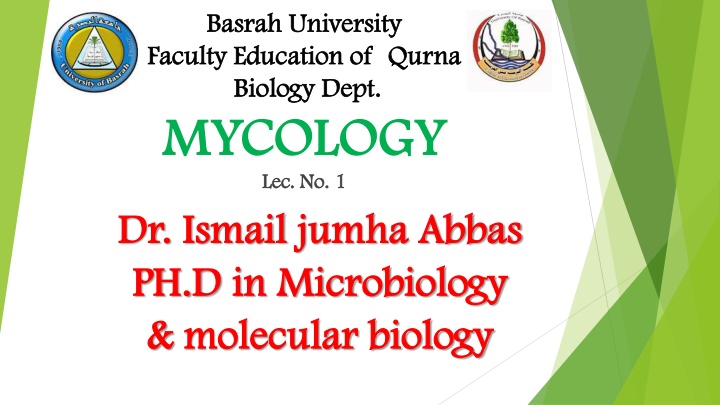
Basrah University Mycology Department Overview
Discover the fascinating world of Oomycota, a class of fungi living in aquatic habitats at Basrah University's Biology Department. Explore the characteristics, orders, and common species like Saprolegnia. Learn about their life cycle, reproduction, and impact on plant and fish diseases. Dive into Peronosporales, another order of parasitic fungi affecting plants with zoospores. Join Dr. Ismail Jumha Abbas on a mycology journey through images and detailed insights.
Download Presentation

Please find below an Image/Link to download the presentation.
The content on the website is provided AS IS for your information and personal use only. It may not be sold, licensed, or shared on other websites without obtaining consent from the author. If you encounter any issues during the download, it is possible that the publisher has removed the file from their server.
You are allowed to download the files provided on this website for personal or commercial use, subject to the condition that they are used lawfully. All files are the property of their respective owners.
The content on the website is provided AS IS for your information and personal use only. It may not be sold, licensed, or shared on other websites without obtaining consent from the author.
E N D
Presentation Transcript
Basrah University Basrah University Faculty Education of Faculty Education of Qurna Biology Dept. Biology Dept. MYCOLOGY MYCOLOGY Lec Lec. . No. No. 1 1 Dr. Dr. Ismail Ismail jumha Abbas jumha Abbas PH. PH.D D in Microbiology in Microbiology & & molecular biology molecular biology Qurna
Phylum: Phylum: Oomycota Oomycota.( .(water Class: Class: Oomycetes Oomycetes General characteristics General characteristics: : 1 1. Fungi living in aquatic habitats . Fungi living in aquatic habitats 2 2. Produce biflagellate zoospores . Produce biflagellate zoospores 3 3. Cell wall composed of cellulose . Cell wall composed of cellulose 4 4. . Hypahe Hypahe are are coenocytic coenocytic (with no septa) 5 5. Asexual reproduction by zoospores in zoosporangia . Asexual reproduction by zoospores in zoosporangia 6 6. Sexual reproduction by . Sexual reproduction by gametangial gametangial contact (oogonia antheridia) antheridia) 7 7. Saprophytes or parasitic nutrition . Saprophytes or parasitic nutrition This class includes two main orders This class includes two main orders Order Order 1 1: : water molds = molds = biflagellates biflagellates) ) (with no septa) contact (oogonia and and
Order Order 1 1: : Saprolegniales Saprolegniales The most common species is The most common species is Saprolegnia This water mold is common in waters. Many species have been This water mold is common in waters. Many species have been found in Shatt Al found in Shatt Al- - Arab Rive: in Iraq. Some species causing fish Arab Rive: in Iraq. Some species causing fish diseases. diseases. Life cycle of Life cycle of Saprolegnia Saprolegnia Asexual reproduction: Zoosporangia are produced at the Asexual reproduction: Zoosporangia are produced at the hyphal tips, zoospores are formed within zoosporangia (Fig tips, zoospores are formed within zoosporangia (Fig 8 8). ). Zoospores release into water then become encysted and Zoospores release into water then become encysted and germinate to give new hyphae sexual reproduction oogonia and germinate to give new hyphae sexual reproduction oogonia and antheridia are produced from hyphae antheridia are produced from hyphae cogonia oospores (fig oospores (fig8 8 )after fertilization between antheridia )after fertilization between antheridia Saprolegnia ( ( Fam Fam saprolegiaceae saprolegiaceae). ). hyphal cogonia containing containing
Order Order 2 2: : Peronosporales Peronosporales Three families are considered in this text: Three families are considered in this text: family 1. Pythiaceae (eg. Pythium) family 2. Peronosporaceae eg. Peronospora) family 3. Albugniaceae (eg. Albugo) Mein Characters: Mein Characters: 1 1. Mostly parasitic on plants . Mostly parasitic on plants 2 2. Living in waters and mist soils . Living in waters and mist soils 3 3. Zoospores . Zoospores bifiagellates bifiagellates 4 4. . Oogonia Oogonia and antheridia present and antheridia present 5 5. Causing various plant diseases (damping off, downy mildews, . Causing various plant diseases (damping off, downy mildews, white rust) white rust)
Genus: Genus: Pythium Pythium This fungus causes This fungus causes damping off seedlings damping off seedlings (Fig. Hyphae ore thin, Hyphae ore thin, zoospomgia zoospomgia spherical formed at the hyphal hyphal tips. Zoospores release from zoosporangium tips. Zoospores release from zoosporangium into a vesicle. Zoospores encyst end germinate into into a vesicle. Zoospores encyst end germinate into new hyphae (Asexual reproduction). Sexual new hyphae (Asexual reproduction). Sexual reproduction by means of reproduction by means of oogonium oogonium and antheridium is occurred. Single oospore is formed within the is occurred. Single oospore is formed within the oogonium oogonium (Fig. (Fig. 11 11). Fertilization occurs then a zygote ). Fertilization occurs then a zygote is formed is formed (Fig.10 10). ). spherical formed at the and antheridium
Life cycle of Life cycle of pythium Hyphae of Hyphae of pythium zoospores containing zoospores. Zoospores zoospores containing zoospores. Zoospores are released into a vesicle and then are released into a vesicle and then librated into water Encysted spore germinates giving into water Encysted spore germinates giving new hyphae. Sexual reproduction occurs by new hyphae. Sexual reproduction occurs by formation of formation of antheridis antheridis and contains a single oospore. Fertilization takes contains a single oospore. Fertilization takes place and place and fertile fertile oospore is produced (Fig. oospore is produced (Fig.12 pythium pythium produce spherical produce spherical librated and oogonium oogonium 12) )
